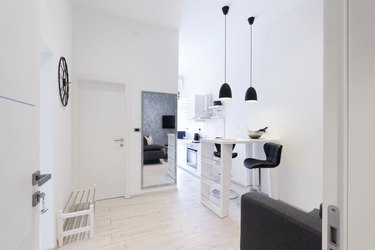
Pergo is a leading name in laminate flooring. Painting Pergo floors, or laminate floors from any other manufacturer, is a hit-or-miss proposition. Home Flooring Pros offers a balanced assessment of the feasibility of painting laminate floors. If, after reading through the relevant post on their site, you still think painting your old Pergo is a better idea than replacing it, two tricky decisions remain before you start.
The first is whether or not to sand the finish. If you don't, the paint might not adhere. If you do, and you sand through it and expose the rough laminate core, the final results may be blotchy. The second decision concerns the paint, and if you make the wrong choice here, your beautiful painted floor won't look beautiful for long.
Video of the Day
Video of the Day
You Must De-Gloss the Finish
The reason Pergo laminate flooring is durable is the finish, not the core material, which is typically medium density fiberboard. If the finish on a plank sustains enough damage to expose the core, the plank usually has to be replaced, so you don't want to remove the finish. You do want to scuff and de-gloss it, though.
The first step in painting Pergo floors, therefore, is to wipe on a de-glossing agent. Alternatively, you can wash it with a strong solution of trisodium phosphate and water (1/2 cup TSP per gallon of water), wearing gloves and goggles to protect yourself from the caustic cleaner.
After the floor dries, a quick way to scuff it is to install a 120-grit sanding screen on a floor buffer and run the buffer over the floor. This procedure, called screening, rarely cuts all the way through the finish, and it's far easier and more efficient than scuffing on your hands and knees using a pad sander.
Apply a Coat of Primer
Perhaps the most important step in the entire procedure is to apply a coat of primer before you paint. Besides protecting any parts of the laminate core that have been exposed by screening — and hopefully there aren't any — primer aids paint adhesion. It sticks better to the laminate finish than paint, and paint sticks better to primer than it does to the laminate finish.
Use a water-based, stain-blocking primer, such as Kilz Premium or Zinsser Bullseye, and spread it with a brush or a roller. Before you do this, you'll want to tape off the walls or the baseboards, if you haven't removed them. A single coat is all it takes, and be sure to let it dry thoroughly before proceeding. White primer makes a great undercoat for white painted wood laminate flooring, but you can tint the primer if you're painting the floor a different color.
Best Paint for Painting Laminate Flooring
Because you're painting a floor, you'll want to stay away from wall paint or interior trim enamel as a final finish. Latex porch and floor enamel is a good choice, but if you want the best results, use an epoxy floor finish, which sets hard enough to protect garage floors from automobile tires.
The trouble with latex floor paint and epoxy coatings is that they come in a limited number of color options. Although you can change the factory hues somewhat by tinting, you don't have the same range of colors that wall paints offer. If you prefer vibrant colors or you're looking for a particular hue, you might do as Tim Carter of Ask the Builder suggests and use wall paint or interior enamel as an undercoat, give it three days to cure and cover it with two or three coats of polyurethane floor finish.